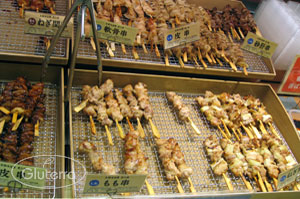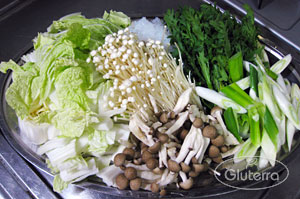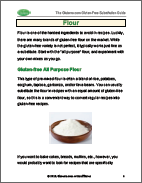Submitted by Kayo on November 2, 2013
 Traveling to foreign countries is always a concern for us because of the language barrier and the lack of gluten awareness in many countries. Even though I grew up in Japan and speak Japanese, traveling to Japan was still a concern for us.
Traveling to foreign countries is always a concern for us because of the language barrier and the lack of gluten awareness in many countries. Even though I grew up in Japan and speak Japanese, traveling to Japan was still a concern for us.
While eating dairy-free in Japan is relatively easy as traditional Japanese food typically contains no dairy, eating gluten free is not an easy task. If you are also soy-free, you will have an even harder time as Japanese tend to eat a lot of soy products. My husband and I are currently visiting Japan. This is the first time he has visited Japan since he started his gluten-free diet. We ordered gluten-free soy sauce bottles and shipped them to my parents house so we can use them when my mom cooks. When we go out, though, we have to choose food carefully.
The biggest challenge you will face eating Japanese food is avoiding soy sauce. Many traditional dishes are cooked with soy sauce which contains wheat. Stick with salt flavored dishes. Miso is most likely okay but there is a type of miso that contains barley. Ask if the miso is "mugimiso". If not, you should be fine. Many western style dishes are also available too, but my husband likes to eat Japanese food as much as possible while we are in Japan.
These are some of the dishes my husband is eating that seem to cause no issues. Please note that he is sensitive to gluten but he is not Celiac. Cross contamination doesn't seem to affect him very much.
Sashimi (raw fish) and sushi
 If you like raw fish, you are in luck. Japan offers some of the freshest fish available. Don't forget to take your own gluten-free soy sauce if you want to use soy sauce.
If you like raw fish, you are in luck. Japan offers some of the freshest fish available. Don't forget to take your own gluten-free soy sauce if you want to use soy sauce.
Grilled fish
You can find many grilled fish dishes that are simply salted. Many traditional Japanese restaurants serve this type of dish, and many come with rice and miso soup.
Salt flavored yakitori (skewered chicken) or kushiyaki (skewered food)
 While cross contamination is unavoidable with this type of dish, skewered food can be grilled and seasoned with salt rather than traditional "tare" (soy sauce based seasoning). There are many types of meats, seafood, and vegetables to choose from. You can often find yakitori for take out.
While cross contamination is unavoidable with this type of dish, skewered food can be grilled and seasoned with salt rather than traditional "tare" (soy sauce based seasoning). There are many types of meats, seafood, and vegetables to choose from. You can often find yakitori for take out.
Korean BBQ
You can ask for salt flavored meats, seafood, and vegetables. Since you grill your own food at the table (there is a grill in the middle of the table), I would think that the cross contamination is minimal and the grill is washed and changed out for each patron.
Hot pots
 Japanese eat different kinds of hot pots. When I say hot pots, I mean the type of dishes that are cooked in broth in a pot (often in clay pots). Gluten-free safe varieties are those that are not cooked in soy sauce based broth. Shabu-shabu (thin sliced beef or pork and vegetables) and yudofu (tofu and vegetables) are two types of dishes that are cooked in simple broth and eaten with dipping sauce. Skip the dipping sauce and they should be okay.
Japanese eat different kinds of hot pots. When I say hot pots, I mean the type of dishes that are cooked in broth in a pot (often in clay pots). Gluten-free safe varieties are those that are not cooked in soy sauce based broth. Shabu-shabu (thin sliced beef or pork and vegetables) and yudofu (tofu and vegetables) are two types of dishes that are cooked in simple broth and eaten with dipping sauce. Skip the dipping sauce and they should be okay.
Snacks
You can find various types of good quality rice crackers. Look for salt flavored kinds. Another great snack is "onigiri" (rice balls) that can be found at convenience stores or shops at train stations. They are great quick snacks or meals. Some ingredients in the middle may contain gluten, so stick with something simple like sour plum (very acquired flavor) or salmon (I'm not sure if salmon flakes are always 100% gluten free, however). Squid and fish jerky are great too, though once again, I'm not sure if they are always 100% gluten-free. My husband doesn't seem to have any problem with these snacks I just mentioned.
Sweets
Many traditional Japanese desserts are made with beans and rice. Aduki bean based dishes with rice cakes or dumplings may be a good one to try. If you are not dairy intolerant, I highly recommend that you try "soft cream" (soft serve ice cream) too. They are rich and silky and so tasty!
Alcohol
 Sake (Japanese call it "nihonshu") is made of rice. If you can find "shochu" that is made of potatoes, it should also be a good option. Many shochu varieties are made of barley, so make sure to get the potato variety. Many mixed drinks made of shochu (called "chuhai" or "Sawaa") are barley based, so be careful. Wines are readily available as well.
Sake (Japanese call it "nihonshu") is made of rice. If you can find "shochu" that is made of potatoes, it should also be a good option. Many shochu varieties are made of barley, so make sure to get the potato variety. Many mixed drinks made of shochu (called "chuhai" or "Sawaa") are barley based, so be careful. Wines are readily available as well.
It's definitely not easy to travel and eat gluten free, but it's certainly not impossible in Japan. That's all I have for now. If you have any questions about traveling to Japan, please feel free to contact me!
- Login to post comments


 Click here to get a FREE GF Substitution Guide!
Click here to get a FREE GF Substitution Guide! 
 Sign-up to become a part of our gluten-free community. As a gift for being a free member, you can download our Gluten-Free Substitution Guide -- over 40 pages of great gluten-free substitutes. As a member, we will also send you our latest updates, recipes, and special offers. We'll try not to bug you and we won't share your info.
Sign-up to become a part of our gluten-free community. As a gift for being a free member, you can download our Gluten-Free Substitution Guide -- over 40 pages of great gluten-free substitutes. As a member, we will also send you our latest updates, recipes, and special offers. We'll try not to bug you and we won't share your info.